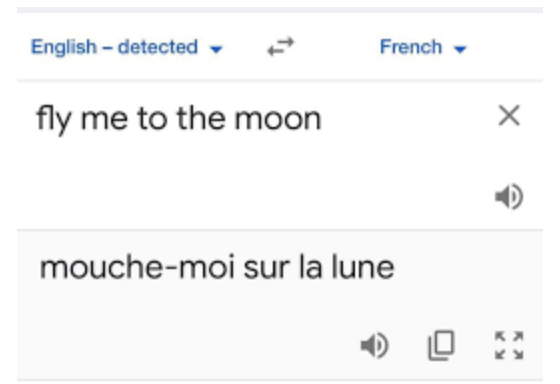It’s no secret that technological advances in the past 30 years especially have gifted translators innovative software and increased productivity in our professional lives. CAT, MT, CMS, TM – these are just some of the acronyms that are volleyed around in the metaphorical digital tennis court of translation, but what exactly are they? Today’s post aims to clear up any questions regarding the tools often found in a translator’s belt, and how they are used to benefit all parties involved with a multilingual project.
MAHT vs. HAMT
Firstly, it’s important to know the difference between Machine Assisted Human Translation (MAHT) and Human Assisted Machine Translation (HAMT).
HAMT is often shortened to just MT (Machine Translation), whereas MAHT is commonly known as Computer Assisted Translation (CAT). We will refer to these two as MT and CAT throughout this blog post for consistency. In a nutshell, the difference between MT and CAT is WHO is responsible for producing the translation.
Google Translate is perhaps the best example of MT that almost everyone will have heard of. The focus here is on the fact that the computer generates the translation, often by using AI, and then this can later be edited by a person. CAT on the other hand is the opposite – a person is in charge of producing the translation, but they are assisted (or aided) by a mix of digital tools which can help to increase a translator’s productivity.
When should you use MT?
Machine Translation may be one of many tools that a translator employs but it is not the sole tool – and it never should be! Even with fast developments in the word of AI and translation aids, Machine Translation still does not have the capacity to understand nuances and subtleties of language, nor can it deduce intent or context of a text. MT therefore can allow for higher rates of inaccurate, inconsistent, and even unintelligible translations if not employed in the right way. Whilst you can get the gist of a short text from Google Translate or similar, the depth of understanding that a person has about language has not yet been taught to machines and AI, and may never be. The way a person’s brain understands and infers meaning from speech and language is proving to be too complex to teach to machine’s at this moment in time.

“Mouche” here means the insect, not the verb!
Uncommon language pairs (take Japanese <> English, for example) throw up many hilarious grammar and lexis mistakes when tapped into a MT programme – even with the simplest of input sentences.
This is not to say that Machine Translation is useless – quite the opposite is true – but it is important for human translators to review computer generated translations and edit them in order for them to be fit for purpose and be professionally acceptable. MT can provide a rough skeleton from which you can flesh out a text and a professional translator will know the limits of this and be able to use it sparingly and insightfully. A common misconception is that some people think that running a translation through MT software and asking a translator to edit the output is a cheaper option than a translator starting on the original document from scratch. On the contrary, this actually takes more time as the MT can be incomprehensible, or contain confusing syntax which the translator has to spend time unpicking and rearranging anyway.
What else can CAT provide?
Machine Translation may be one of many tools that a translator employs but it is not the sole tool – and it never should be! Even with fast developments in the word of AI and translation aids, Machine Translation still does not have the capacity to understand nuances and subtleties of language, nor can it deduce intent or context of a text. MT therefore can allow for higher rates of inaccurate, inconsistent, and even unintelligible translations if not employed in the right way. Whilst you can get the gist of a short text from Google Translate or similar, the depth of understanding that a person has about language has not yet been taught to machines and AI, and may never be. The way a person’s brain understands and infers meaning from speech and language is proving to be too complex to teach to machine’s at this moment in time.
Many CAT tools are cloud-based platforms. This means that no documents are stored directly on the translator’s workstation, allowing for greater security on both sides of the translation exchange. This confidentiality is vital, especially when dealing with sensitive documents.
As well as increased security and MT, CAT tools provide translators with an array of other useful tools. For example:
Translation Memories: Translation Memories, or TMs, allow previous translations to be stored and searched for in a database and then automatically recalled at a later date. Terms you have previously translated are suggested as possible solutions in the future. Translation Memories work across projects regardless of client. Experienced translators will have many Translation Memories and will be able to select the appropriate one to reference when starting a new project.
Many translators charge per word, but repeated words and previously translated words are often not counted in this price. If a CAT tool can automatically fill in parts of a translation before the translator has even sunk their teeth into it, this means clients will pay less for the final translation and the turnaround time of the translation will be quicker. Happy clients all round!
Project Management Systems: This allows all of a translator’s projects to be stored in one place. This often includes client details, which means that communication between client and translator is easy, quick, and seamless.
A project manager can assign work to a whole team of translators which allows for great collaboration in terms of editing, commenting on, and perfecting each other’s work. This is especially useful when dealing with large projects.
Term Bases: Term bases can be curated by the translator or provided by the client. Clients often send term bases over with their translation requests to ensure that certain terms are translated how they wish.
Formatting Tools: These allow the translator to match the layout of the translation exactly to that of the original language document. Hyperlinks, colour, bolding, fonts, images – all of these can be easily preserved using CAT and therefore achieve consistency and continuity.
In summary
CATs – what a useful and supportive friend to have! Clients receive completed, consistent, and accurate translations for a smaller fee, and documents are returned in a shorter time frame. There are many other tools that CAT tools can provide, and in turn a wide array of benefits for both client and translator. The translation process goes hand in hand with these tools as they allow for enhances productivity and improve the overall experience of translation. Even with advances in CAT technology, real-life, human translators remain the foundations of a high-quality translation process and know how to seamlessly blend personal knowledge with digital tools to achieve optimum success.




